2 Operating System structures
1 Operating system service¶
The figure below is a view of the various operating-system services and how they interrelate.

2 User and Operating System interface¶
There're mainly three ways for users to interface with the operating system:
- command interpreter
- graphical user interface
- touch-screen interface
3 System calls¶
Purpose of System Call: System calls provide an interface to the services made available by an operating system.
Example
A simple program to read data from one file and copy them to another file: cp in.txt out.txt. As you can see, even simple programs may make heavy use of the operating system.
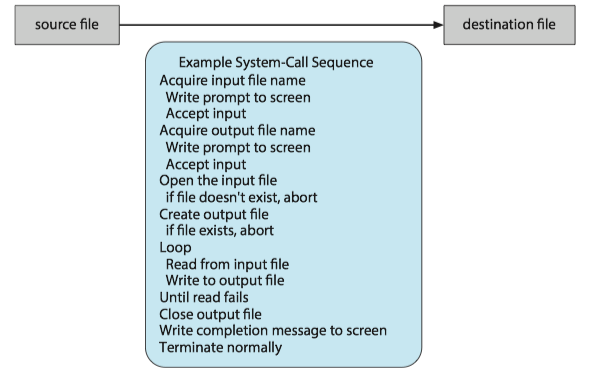
API¶
Typically, application developers design programs according to an application programming interface(API, 应用程序编程接口) rather than invoking actual system call.
- because even simple program may make heavy use of system call.
- program portability: expect programs to compile and run other system that supports the same API
- run-time environment(RTE, 运行时环境) - the full suit of software needed to execute applications, including its compilers, interpreters, libraries, loaders.
Types of system calls¶
System calls can be grouped roughly into six major categories: 系统调用可分成六大类:进程控制,文件管理,设备管理,信息维护,通信和保护。
- process control
- file management
- device management
- information maintenance
- communications
- protection
Example
The following illustrates various equivalent system calls for Windows and UNIX operating systems.
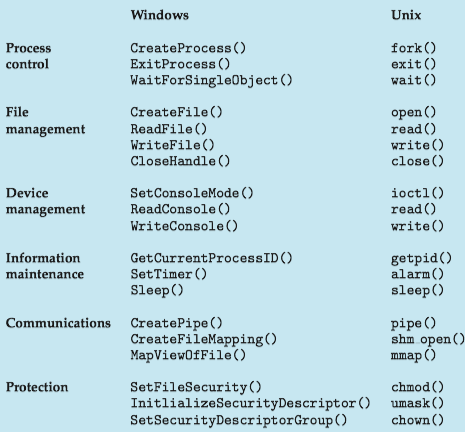
Three ways to pass parameters to the operating system:
- when less than five parameters, passing the parameters in registers
- when more than five parameters, parameters are stored in a block, passing the address of the block in a register
- using stack
4 System Services¶
System services, also known as system utilities, provide a convenient environment for program development and execution.
They can be divided into these categories:
- File management
- Status information
- File modification
- Program loading and execution
- Communications
- Background services
7 OS Design and Implementation¶
One important principle of OS design is the separation of policy from mechanism . Mechanisms determine how to do something; policies determine what will be done. 操作系统设计的一个重要原则是策略(policy)和机制(mechanism)的分离。机制决定如何做,策略决定做什么。
- The separation of policy and mechanism is important for flexibility.
8 Operating system structure¶
Monolithic structure¶
Operating systems with monolithic(宏内核) structure place all of the functionality of kernel into a single, static binary file that runs in a single address space.
- a common technique for designing operating system
- e.g. original Unix operating system ( figure below)
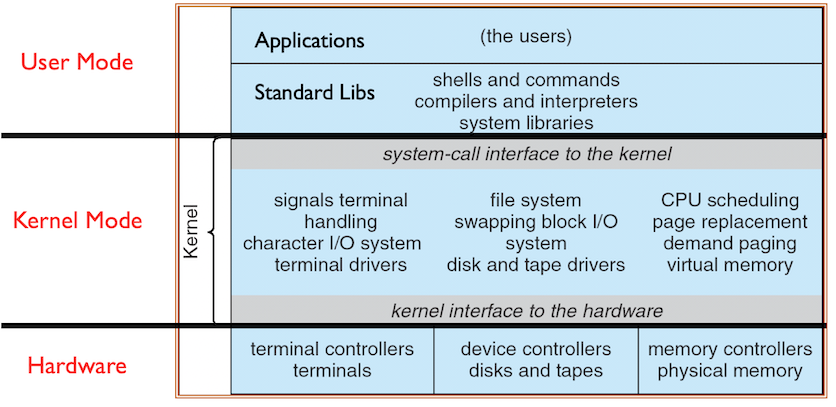
monolithic kernel单内核
- e.g. Linux is based on Unix and is structured similarly, as shown in figure below.
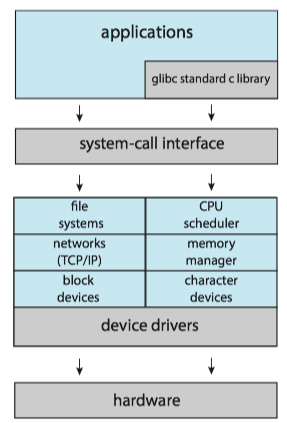
pros:
- simplicity of kernels
- a distinct performance advantage
- very little overhead in the system-call interface
- fast communication within the kernel
cons
- difficult to implement and extend
Layered¶
A loosely coupled (松耦合) system is divided into separate, smaller components that have specific and limited functionality (modular approach). All these components together comprise the kernel.
- changes in one component affect only that component
A system can be made modular in many ways.
- one way is the layered approach.
For the layered operating system (层次式操作系统), it is broken into a number of layers.
- The bottom layer is the hardware; the highest is the user interface.
- low-level layers can be invoked by higher-level layers
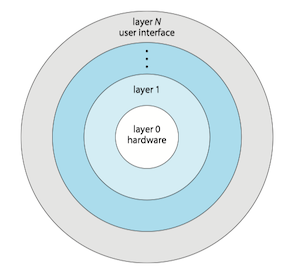
pros:
- Simplicity of construction and debugging
- Each layer is implemented only with operations provided by lower-level layers.
- Higher-level layers can be debugged without any concern for the lower-level layers
cons:
- Difficulty of defining the functionality of each layer
- Poor performance
- Overhead of requiring a user program to traverse through multiple layers to obtain an operating-system service
Layered systems have been successfully used in computer networks (such as TCP/IP) and web applications.
Microkernel¶
Another way to modularized the kernel is using microkernel(微内核) approach.
- Removing all nonessential components from the kernel and implementing them as user-level programs the reside in separate address spaces.
- A smaller kernel.
A typical microkernel shown below.
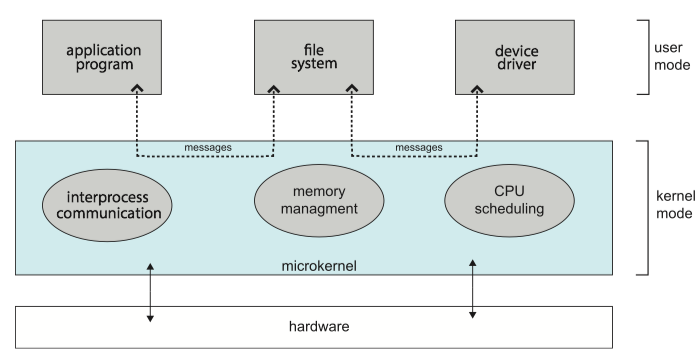
Monolithic Kernels VS Microkernels:
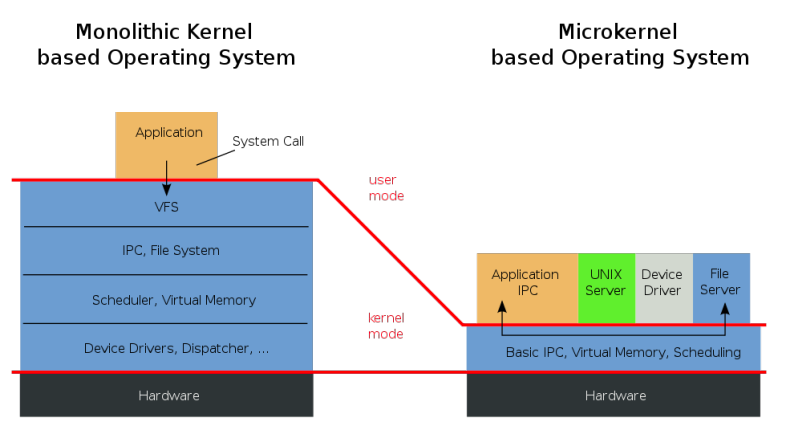
Pros:
- Easy to extend the os
- All new services added to user space do not require modification of the kernel.
- When modification of kernel needed, changes tend to be fewer because of small kernel
- more security and reliability
- since most services are running as user
Cons:
- Performance may suffer due to increased system function overhead.
- Because messages of user-level services to communicate must be copied between the services, which reside in separate space.
- The os may have to switch from one process to the next to exchange the messages.
Best-known microkernel os is Darwin, the kernel component of the macOS and iOS.
Modules¶
Perhaps the best current methodology for operating system design involves using loadable kernel modules(LVMs, 可装载内核模块). Here, the kernel has a set of core components and can link in additional services via modules, either at boot time or during run time.
- design purpose: for the kernel to provide core services, while other services are implemented dynamically, as the kernel is running
Example
You can list all Linux kernel modules that are currently loaded, by entering the command lsmod(lists name, size, and where the module is being used).
Linux kernel modules are loaded(inserted) using the insmod command, and are removed using the rmmod command.
Hybrid systems¶
In practice, very few operating system adopt a single, strictly defined structure. Instead, they combine different structures, resulting in hybrid systems that address performance, security, and usability issues.
Architecture of Apple’s macOS and iOS operating systems:
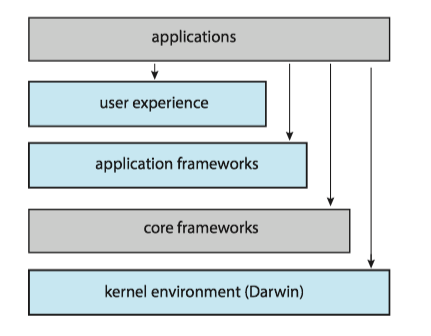
Darwin provides two system-call interfaces: Mach system calls and BSD system calls.
The structure of Darwin:
To address such performance problems, Darwin combines Mach, BSD, the I/O kit, and any kernel extensions into a single address space.
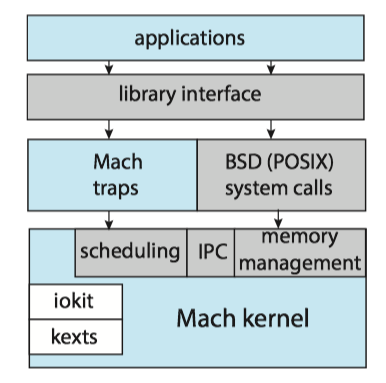
9 System boot¶
The process of starting a computer by loading the kernel is known as booting the system.
- A small piece of code known as the bootstrap program(引导程序) or boot loader locates the kernel.
- The kernel is loaded into memory and started.
- The kernel initializes hardware.
- The root file system is mounted.
Bootstrap program: